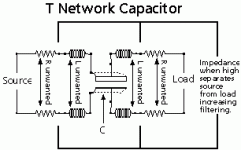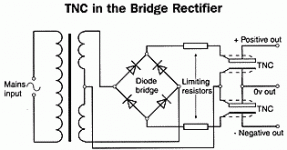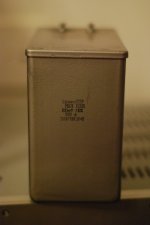He's filtering PS! There ain't supposed to be anything in there but what's coming out of the rectifier... No mention of any noise or even a suggestion that anything else is there. Nothing other than a nearly "perfectly tuned" amp that "didn't sound real."...
You're forgetting the audio current, unfortunately it doesn't all cancel in the opt, although an inductor in series with the center tap would force it to balance - probably would not be great on the LF end of things. (Use smallish inductor and force "perfect" balance above a few hundred Hz?) This is an old WE trick that I have not (yet) tried. In fact a CCS driving the center tap would do the same thing, wonder what it would sound like, no audio current in the supplies, but class A only.. (Or some sort of CCS modulation based on instantaneous power level - probably audible..)
Last edited:
You're forgetting the audio current, unfortunately it doesn't all cancel in the opt, although an inductor in series with the center tap would force it to balance - probably would not be great on the LF end of things. (Use smallish inductor and force "perfect" balance above a few hundred Hz?) This is an old WE trick that I have not (yet) tried. In fact a CCS driving the center tap would do the same thing, wonder what it would sound like, no audio current in the supplies, but class A only.. (Or some sort of CCS modulation based on instantaneous power level - probably audible..)
I posed that question of output signal getting back into the first filter in a post way back toward the start of the thread. But that would be seen without difficulty. It wasn't even a consideration in the opening post.
I posed that question of output signal getting back into the first filter in a post way back toward the start of the thread. But that would be seen without difficulty. It wasn't even a consideration in the opening post.
It is hard to imagine how output signal is getting back into the first filter, but it is obvious that an output stage of the amp draws the current from it, so this current is modulated. And if capacitors had constant, current-independent capacitance, such effect would not present, no matter how hard "output signal is getting back into the first filter". Also, if perception of phase angle between stereo channels would not be 1000 times less than some engineers still believe, it would not be audible as well.
... wonder what it would sound like, no audio current in the supplies, but class A only.. (Or some sort of CCS modulation based on instantaneous power level - probably audible..)
Michael Koster has/had an amp which was CCS fed. I think Gary Pimm also has a ccs fed amp. The amp I'm using at the moment has it also, however its a SE amp. Its here:
http://www.diyaudio.com/forums/tube...plifier-2a3-d3a-ccs-coupled-new-topology.html
and here:
http://www.diyaudio.com/forums/tubes-valves/161765-10m45s-strange-behaviour-100ma.html
I build it with a 2a3/40 and a d3a.
Maybe its coincidence, but it is the amp with the most stable stereo imaging i've ever heard. There is only one cap in the signal path, and thats a (very old) paper in oil for the parafeed.
Last edited:
It is hard to imagine how output signal is getting back into the first filter, but it is obvious that an output stage of the amp draws the current from it, so this current is modulated. And if capacitors had constant, current-independent capacitance, such effect would not present, no matter how hard "output signal is getting back into the first filter". Also, if perception of phase angle between stereo channels would not be 1000 times less than some engineers still believe, it would not be audible as well.
If the transformer isn't perfectly balanced at the CT for all frequencies reproduced there will be audio at the center tap. I suspect dynamic match of the output tubes would also play a significant role. Western Electric addressed this issue in their early designs by using a fairly large choke in series with the center tap. This I suspect also substantially improved balance at 120Hz and helped with ripple rejection in the output stage as the supply caps in these amps were pretty small. (These amps were used with efficient speakers that reproduced to well below 100Hz..)
Yeah, the current drawn from the supply is modulated, but if the transformer is perfectly balanced the current envelope should just follow the signal level above the point where the power stage transitions from class A to class AB.. This is pretty low frequency stuff obviously..
If the transformer isn't perfectly balanced at the CT for all frequencies reproduced there will be audio at the center tap. I suspect dynamic match of the output tubes would also play a significant role. Western Electric addressed this issue in their early designs by using a fairly large choke in series with the center tap. This I suspect also substantially improved balance at 120Hz and helped with ripple rejection in the output stage as the supply caps in these amps were pretty small. (These amps were used with efficient speakers that reproduced to well below 100Hz..)
Yeah, the current drawn from the supply is modulated, but if the transformer is perfectly balanced the current envelope should just follow the signal level above the point where the power stage transitions from class A to class AB.. This is pretty low frequency stuff obviously..
I am afraid it does not matter, is the amp SE or PP, is it in class A or in class C, anyway current is drawn from PS, not from one tube to another tube. However, a choke in series with PS would absorb some common-mode errors in case of class A P-P amp, but anyway tubes don't complement each other perfectly, so some current variations would always exist. And no shunt capacitor is perfect, so some non-linearities will remain...
What I've learned from this case, even tiny non-linearities in power supply capacitors can cause audible difference in soundstage perception. Add here dynamic input capacitances of amplification stages that are not linear; electrolytic coupling capacitors in CD players; even non-linear capacitances and inductances in recording gear, and we know a little bit more the Structure of Magic: how to preserve stereo images!
<snip>
What I've learned from this case, even tiny non-linearities in power supply capacitors can cause audible difference in soundstage perception. Add here dynamic input capacitances of amplification stages that are not linear; electrolytic coupling capacitors in CD players; even non-linear capacitances and inductances in recording gear, and we know a little bit more the Structure of Magic: how to preserve stereo images!
Of course SE is even worse since the supply really is in the path and not just practically speaking.. (Ultrapath and parafeed aside) 😀
Yeah it is amazing how these little details that are hard to verify rigorously can sometimes make a very big subjective difference..
Electrolytics sound bad. And, they get worse as they get older. They also sound bad if you don't power them up regularly (problems of 'forming'). Bypassing does not fix these faults!
Totally agree with Rod.

Totally agree with Rod.
Totally agree with you both: vacuum triodes are bad as well. Their amplification factor depends on current and varies with signal. They have capacitances between grids and anodes. Amplification factor * capacitance between plate and grid = miller capacitance that is not linear since amplification factor varies with amplified signals.
Also, triodes have internal resistance. Internal resistance of driving stage with Miller capacitance of driven stage form a network that modulates phase shift of the signal by the signal itself.
Oh boy! 😱
Also, tubes are bad because their internal resistances are modulated by signal! Multiply one non-linearity by another and you get higher order of non-linearities!
Conclusion: everything is bad except bees: they bring honey. No, bees age bad at all, they bite!
But seriously speaking, thanks to electrolytics we can have light compact capacitors. If to know their character and shunt by film capacitors their weaknesses we can have nice compact equipment. Like, if to know that bees bite and behave accordingly, you can eat honey! Yammy! 🙂
Totally agree with you both: vacuum triodes are bad as well. Their amplification factor depends on current and varies with signal. They have capacitances between grids and anodes. Amplification factor * capacitance between plate and grid = miller capacitance that is not linear since amplification factor varies with amplified signals.
Also, triodes have internal resistance. Internal resistance of driving stage with Miller capacitance of driven stage form a network that modulates phase shift of the signal by the signal itself.
Oh boy! 😱
Also, tubes are bad because their internal resistances are modulated by signal! Multiply one non-linearity by another and you get higher order of non-linearities!
Conclusion: everything is bad except bees: they bring honey. No, bees age bad at all, they bite!
But seriously speaking, thanks to electrolytics we can have light compact capacitors. If to know their character and shunt by film capacitors their weaknesses we can have nice compact equipment. Like, if to know that bees bite and behave accordingly, you can eat honey! Yammy! 🙂
I knew there was something wrong with me, I like triodes and bees.. Watch out for their capacitors though! 😀 😀 😀
In case anyone is interested, there are some nice ASC 600uF 500VDC MKP caps on ebay right now for $19 each (plus shipping)!!!!!!
New ASC GLY513 600uF/500VDC 500V Metal-Poly Capacitors on eBay (end time 26-Dec-10 08:08:31 GMT)
That's one big MKP cap 🙂
New ASC GLY513 600uF/500VDC 500V Metal-Poly Capacitors on eBay (end time 26-Dec-10 08:08:31 GMT)
That's one big MKP cap 🙂
In case anyone is interested, there are some nice ASC 600uF 500VDC MKP caps on ebay right now for $19 each (plus shipping)!!!!!!
New ASC GLY513 600uF/500VDC 500V Metal-Poly Capacitors on eBay (end time 26-Dec-10 08:08:31 GMT)
That's one big MKP cap 🙂
quote:
Shipping weight is 3lbs/2Kg per capacitor.
Wow! 😱
Does anyone know how the ASCs sound?
I have tried out the plastic-enclosed MKP motor-runs from the Farnell catalogue, even the 660VAC monster sized type. These sound TERRIBLE, worse than electrolytics. I suspect there is no need for them to be wound at a high tension, like the MKP Claritycaps & Ampohms - which sound excellent in the B+ position, right after the rectifier (small values), or on the other side of the choke.
It's a pity Denis Morecroft does not build valve amps, otherwise we might have some high voltage versions of his 'T-network' capacitor. These are designed to solve problems like Wavebourn's, where the same capacitor connects to the rectifier AND the amplifier load.
The drawings tell the tale. In the T-network cap, the rectifier sees one set of parasitic L and R, the load sees another. Thus, you largely avoid voltage intermodulation between source and load.
For an 800V power supply, and 235uF, the rectifier peak current is ~600mA when 100mA dc is drawn. The reverse recovery pulses will be a least as large, but their spectrum will extend well into VHF. I suspect that investigating the sonic consequences of this intermodulation - e.g. by using 2 similar capacitors, and putting a choke between them, would prove interesting.
DNM Products - T-Network Capacitors, full details
I have tried out the plastic-enclosed MKP motor-runs from the Farnell catalogue, even the 660VAC monster sized type. These sound TERRIBLE, worse than electrolytics. I suspect there is no need for them to be wound at a high tension, like the MKP Claritycaps & Ampohms - which sound excellent in the B+ position, right after the rectifier (small values), or on the other side of the choke.
It's a pity Denis Morecroft does not build valve amps, otherwise we might have some high voltage versions of his 'T-network' capacitor. These are designed to solve problems like Wavebourn's, where the same capacitor connects to the rectifier AND the amplifier load.
The drawings tell the tale. In the T-network cap, the rectifier sees one set of parasitic L and R, the load sees another. Thus, you largely avoid voltage intermodulation between source and load.
For an 800V power supply, and 235uF, the rectifier peak current is ~600mA when 100mA dc is drawn. The reverse recovery pulses will be a least as large, but their spectrum will extend well into VHF. I suspect that investigating the sonic consequences of this intermodulation - e.g. by using 2 similar capacitors, and putting a choke between them, would prove interesting.
DNM Products - T-Network Capacitors, full details
Attachments
quote:
Shipping weight is 3lbs/2Kg per capacitor.
Wow! 😱
These are light. Do you know what the russian equivalent weighs? Carried a couple of these in my suitcase once...
Attachments
I am afraid it does not matter, is the amp SE or PP, is it in class A or in class C, anyway current is drawn from PS, not from one tube to another tube. However, a choke in series with PS would absorb some common-mode errors in case of class A P-P amp, but anyway tubes don't complement each other perfectly, so some current variations would always exist. And no shunt capacitor is perfect, so some non-linearities will remain...
What I've learned from this case, even tiny non-linearities in power supply capacitors can cause audible difference in soundstage perception. Add here dynamic input capacitances of amplification stages that are not linear; electrolytic coupling capacitors in CD players; even non-linear capacitances and inductances in recording gear, and we know a little bit more the Structure of Magic: how to preserve stereo images!
I'm afraid I don't buy any of it so far (the explanation of why, not doubting it sounds different) . No one has come up with a shred of physical evidence (measure current in the bypass cap?) nothing but a bunch of handwaving.
What you hear could have any number of causes, and you've done nothing to demonstrate the above claim, that it happens on other amps, other topologies.
Why are so many so eager to go along?
Anatoliy, What are you trying to teach us?
Last edited:
Anatoliy, What are you trying to teach us?
Nothing, Michael! I am not a Teacher. I learn here. I opened the topic to ask if somebody has some explanations... 😉
However, I have my own working hypothesis, and it may be wrong...
These are light. Do you know what the russian equivalent weighs? Carried a couple of these in my suitcase once...
It is metal film on paper, in oil. It should be more massive.
These are light. Do you know what the russian equivalent weighs? Carried a couple of these in my suitcase once...
The only reason I have not bought these-and I have been sorely tempted-is the chassis would, I think, have to be positively cavernous.
These are light. Do you know what the russian equivalent weighs? Carried a couple of these in my suitcase once...
I have a couple of these, but not such high values of capacitance. 10mF only. And yes, they are huge.... and heavy.
- Status
- Not open for further replies.
- Home
- Design & Build
- Parts
- Mumbo-Jumbo and power supply caps


